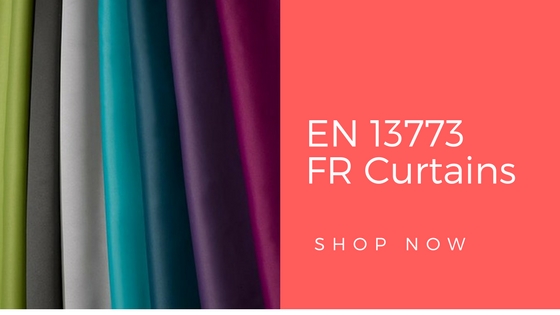Fire Retardant Curtain Regulations
Understanding Fire Retardant Curtain Regulations.
When working in contract curtain environments it is a legal requirement in various countries for the curtains to be certified to fire retardant standards. In this article, we are going to go through the major fire retardant standards and what is required in different countries and applications.
All of Direct Fabrics flame retardant range is compliant to BS5867 Part2B and some to BS5867 Part 2C.
You can purchase fire resistant curtains here from our range here.
This guide is an overview of the various fire retardant curtain regulations and will be added to overtime.
Included in this Article about fire retardant curtain regulations
Further information is included for each particular standard can be found in the links below.
Why do we need flame retardancy regulations
Regulations are quite simply designed to save lives. By ensuring that fabrics and manufactured products conform to the fire retardancy requirements means that customers are safe knowing that the fire risk is reduced and thus they are safer.
Fire Retardant Curtain Standards United Kingdom BS5867
Let's jump in and look at our main market which is the United Kingdom. Domestic curtain fabrics will not normally be flame retardant. Always check the product information to see whether they have the following regulations.
BS5867 - British standard for drapery including curtains and blinds.
This standard covers everything that you require for fire retardant curtains in the United Kingdom.
The standard is broken up into 2 sections;
Part2B which is 10 washes whilst staying flame retardant.
Part2C which is 50 washes / inherently flame retardant.
Areas of use for BS5867
- Hotels, Care Homes, Schools, Hospitals, Medical Centres, Village Halls, Commercial Offices
Products Available to Flame Retardant Standards BS5867
Care Home Regulations for Fire Retardant Curtains
When working in care environment the goal is to keep residents safe and keep the care home compliant to any regulations set out by the government and the Care Quality Commission (CQC).
The CQC have stated that you need to be inline with their framework under regulation 15: Premises and Equipment. This works in conjunction with the government specifics for public spaces.
Per DCLG (department for communities and local government) fire risk assessment guides, curtains and drapes should be compliant to - BS 5867-2: Specification for fabrics for curtains and drapes. Flammability requirements. British Standards Institution – Page 55 of the guide below.
Fire retardant Curtains Standard for Europe M1 France B1 Germany
When working in the European marketplace the fire retardant codes for France and Germany are M1 and B1 respectivly. These flame retardant standards are similar to the United Kingdom BS5867. The main difference is teh M1 standard is a very high level of flame retardancy. Usually but not always a fabric that conforms to BS5867 Part 2C and is inherently flame retardant will pass the higher regulation of France M1.
Getting fabrics tested to flame retardant standard M1 has to be done in France as the French testing house are the only locations that are certified to perform the M1 Test. This means it can be quite expensive to get this product tested and will involve sending fabrics overseas to get them tested.
The M1 test is a vertical test to see how the flame spreads across a panel of fabric over a duration of being ignited.
You can review a more indepth review of the M1 and B1 standard here
- B1 (DIN 4102 B1)
German Flame Retardancy Standard for flame retardant building products. Materials that have been finished in accordance with B1 must self extinguish after the ignition source has been removed. - M1 (French Flame Retardancy Standard)
Corresponds approximately to the German DIN 4102 B1.
Areas of use for M1 B1
- Hotels, Care Homes, Schools, Hospitals, Medical Centres, Village Halls, Commercial Offices
Products Available to Flame Retardant Standards M1 B1
Fire Retardant Curtains Standard EN13773 European Contract Textiles
The 13773 is a similar regulation to M1 B1 and is a vertical ignition test. It is for the European market






